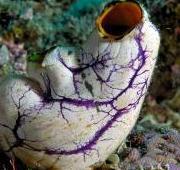 The sea squirt is an immobile filter feeder that live on the ocean floor. Despite their plant-like appearance, sea squirts are actually more closely related to vertebrates than they are to invertebrates such as sponges and coral.
The sea squirt is an immobile filter feeder that live on the ocean floor. Despite their plant-like appearance, sea squirts are actually more closely related to vertebrates than they are to invertebrates such as sponges and coral. There are more than 3,000 known sea squirt species found on the seabed around the world, with the majority of sea squirt species being found in the warmer, nutrient-rich tropical waters. Sea squirts can vary from just 3cm to 30cm in length depending on the species of sea squirt and its habitat.
There are more than 3,000 known sea squirt species found on the seabed around the world, with the majority of sea squirt species being found in the warmer, nutrient-rich tropical waters. Sea squirts can vary from just 3cm to 30cm in length depending on the species of sea squirt and its habitat.


Sea squirts primarily feed on the plankton and nutrients in the water along with the algae that grows on them. Many larger sea squirt species have stick tentacle-like appendages which catch food particles as they float past. Some really large species of sea squirts that are found in the deep ocean, are even known to trap and ingest small animal including fish and jellyfish.
Due to the fact that sea squirts attach themselves to objects from a very young age, they are often sitting targets for hungry passers. Snails, crustaceans and eels are the most common predators of the sea squirt along with some species of larger fish.
Sea squirts have both male and female reproductive organs making self-fertilisation possible but unlikely. The sea squirts release their eggs and sperm into the water which become fertilised and part of the plankton. The sea squirt larvae hatches out of the eggs and makes it way down to the ocean floor in search for somewhere to anchor itself.

